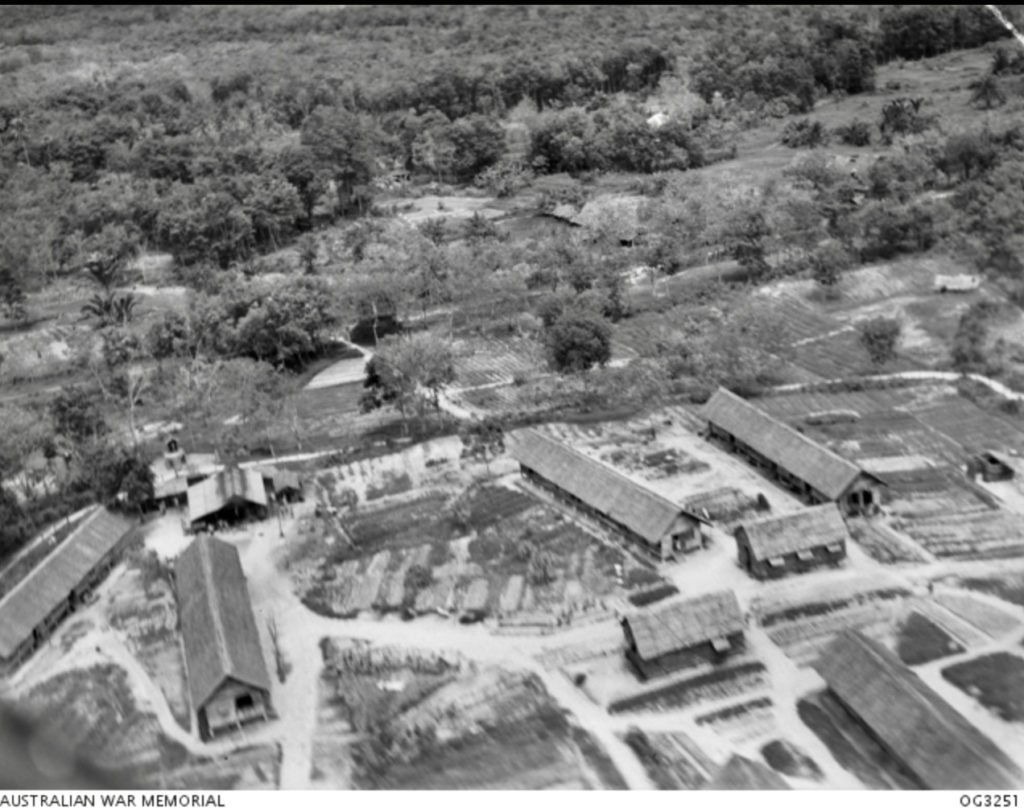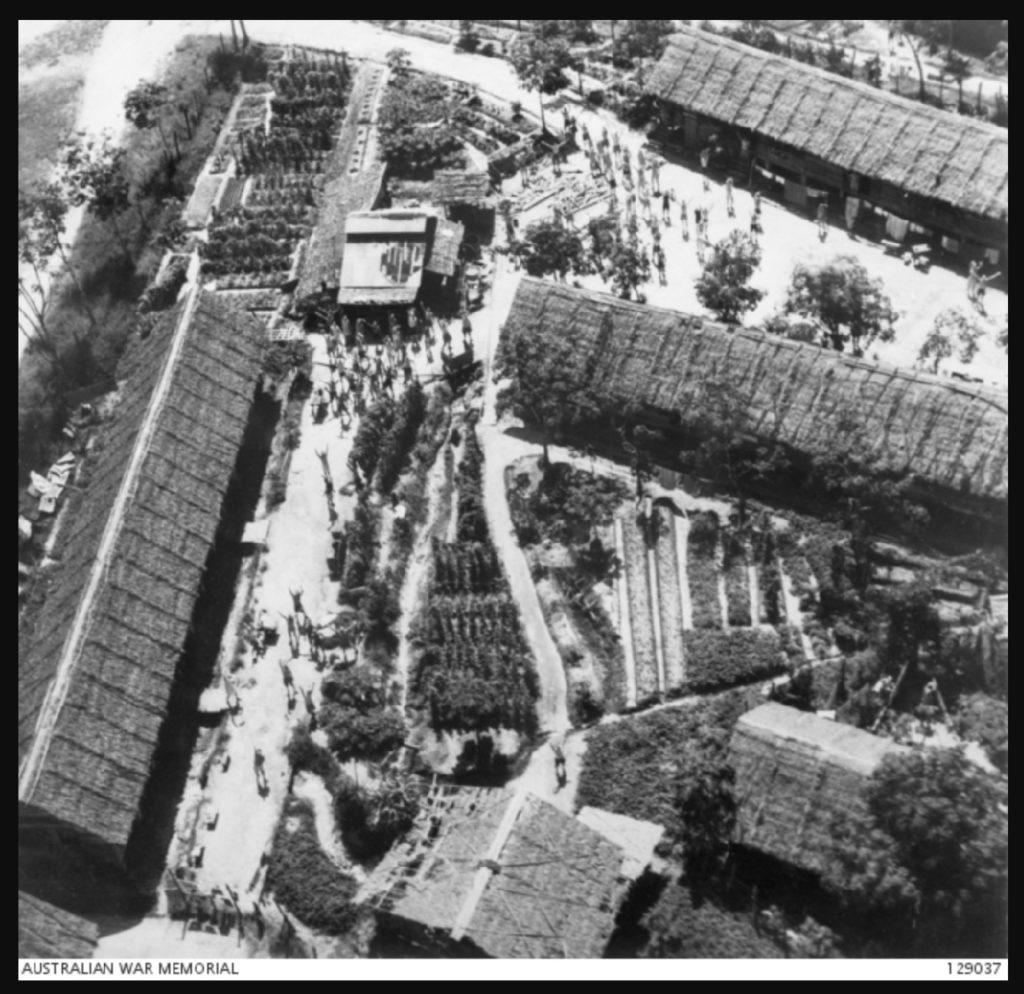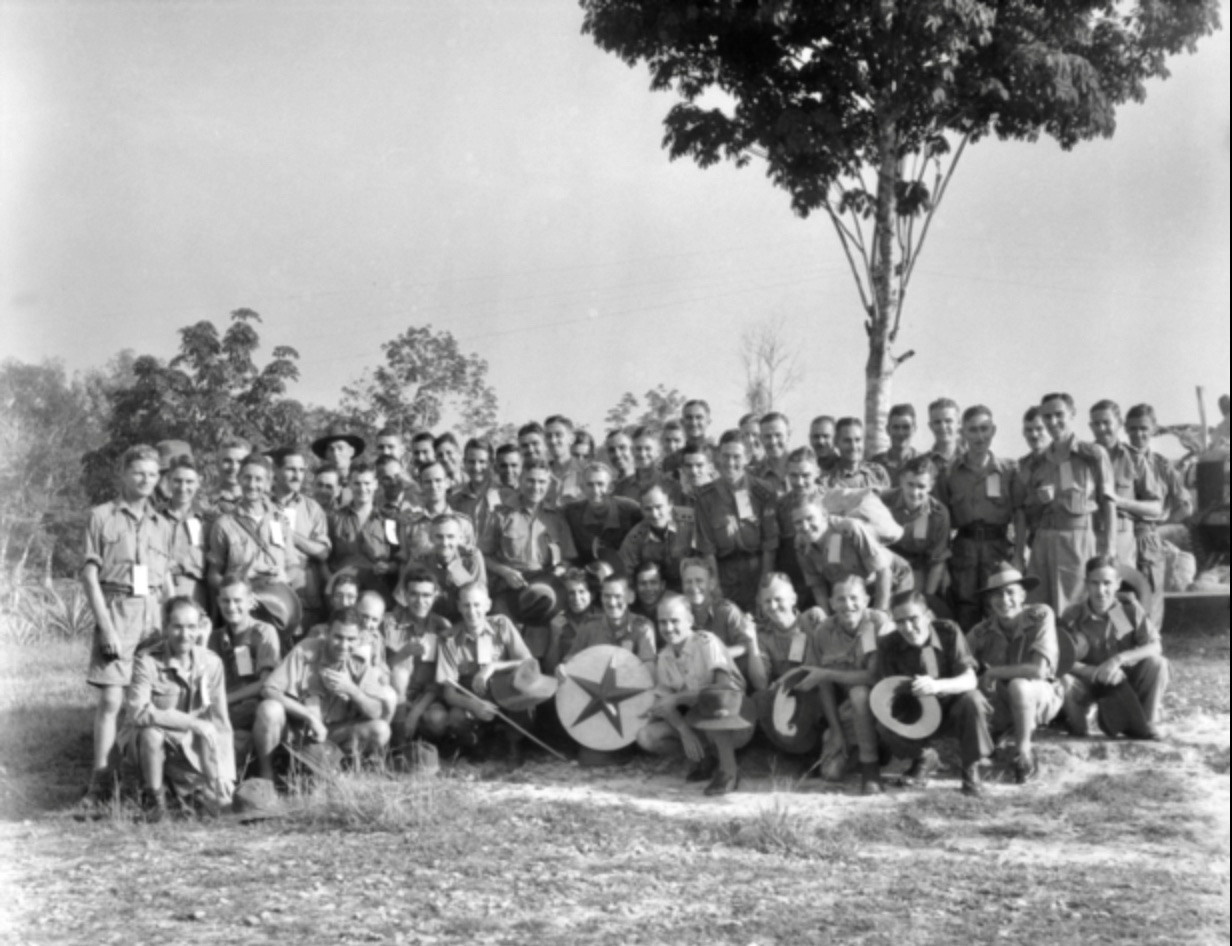Lintang Officers Camp, Kuching – Sarawak
Batu Lintang camp (also known as Lintang Barracks and Kuching POW camp) at Kuching, Sarawak on the island of Borneo was a Japanese internment camp during the Second World War. It was unusual in that it housed both Allied prisoners of war (POWs) and civilian internees. The camp, which operated from March 1942 until the liberation of the camp in September 1945, was housed in buildings that were originally British Indian Army barracks. The original area was extended by the Japanese, until it covered about 50 acres (20 hectares). The camp population fluctuated, due to movement of prisoners between camps in Borneo, and as a result of the deaths of the prisoners. It had a maximum population of some 3,000 prisoners.
On the morning of 28th March 1943 ‘E’ Force departed Changi for Kuching, Sarawak on the de Klerk. The force consisted of 500 AIF and 500 British soldiers including 36 members of the 2/4th Machine Gun Battalion. On arrival E Force camped at Kuching for 8 days before later moving on to Borneo arriving at Sandakan 9th April 1943.
The Japanese in Borneo were fearful of a PW uprising, certainly this was part of the reason for the 1945 death marches to Ranau and the transfer of Australians from Sandakan in 1942 and 1943 was largely as the result of events at the latter camp.
Following two escape attempts within weeks of ‘B’ Force’s arrival at Sandakan, the Japanese started separating the officers from their men. On 27 October 1942 a party of seven senior officers including Lt John Morrison and Lt Brian Walton of the 2/4th and five others left Sandakan for Kuching, arriving on 3 November. Here they formed the basis of the Australian officers’ camp and were joined by the two senior AASC officers, who had been taken to Kuching by the kempai tai for interrogation about the Sandakan escape attempts.

Flying over the prisoner of war camp (POW) in Batu Lintang at a low height, RAAF Beaufighter pilots reported sighting white POWs, clad in khaki shorts, who excitedly waved as the RAAF aircraft flew over to drop leaflets announcing Japan’s surrender. One pilot also reported having seen white women who could have been either nurses or nuns. Close examination of this first picture to arrive from Labuan shows some of the figures standing in the doorways of the huts, waving to the RAAF pilots. This image is believed to have been taken by the navigator of a Beaufighter aircraft possibly of 30 Squadron RAAF, whilst on operations to drop leaflets and to investigate the POW camp on 22nd August 1945.


Kuching Force. The first groups of recently released Australian prisoners of war (POWs) to be repatriated to Australia via Labuan. A group of 8 Division officers wait to leave Lintang Barracks. Back row, left to right (across top): possibly NX70896 Lieutenant (Lt) Frederick Stanley Grenfell Hollway, 2/15 Field Regiment, far left (1); Lt Hugh Thomas, 2/10 Field Regiment, obscured, wearing hat (2); unidentified (3); unidentified, partly obscured (4); Lt John Morrison, 2/4 Machine Gun Battalion (5); unidentified (6); Lt Jim Thom, 2/19 Battalion (7); unidentified (8); Lt E (Gordon) Solomon, 2/18 Battalion (9); Lt L ‘Bunny’ Glover, 2/26 Battalion (10); Maurie Brennan (11); unidentified (12); Lt Keith Moore, 2/15 Field Regiment (13); Lt G ‘Dig’ Gettens, 8 Division Signals (14); QX6348 Captain (Capt) J J ‘Jack’ Rowell 2/10 Field Regiment and of Toowong, Qld (15); unidentified (16); Lt A (Bruce) Walton, 2/4 Machine Gun Battalion (17); Lt Sel Shand, 2/10 Field Regiment (18); Capt Claude Pickford, Australian Army Service Corps (AASC) (19); Lt Ken Crawford, 2/10 Field Regiment (20); QX6328 Capt A C (Maurie) Arvier, 2/10 Field Regiment and of Brisbane, Qld (21); Lt John Poole, Australian Army Ordnance Corps (22); SX10503 Lt Lewis Hugh William ‘Bill’ Bowden, 2/15 Field Regiment (23); Lt Les Kelly, 2/29 Battalion (24); Lt Jock McLean, 2/10 Field Regiment (25); Lt R ‘Bob’ Ellis-Flint, 2/19 Battalion (26); Lt Clive Bayliss, 2/29 Battalion (27); Lt Keith White, 2/20 Battalion (28); John Rogers, Chaplain (29); Lt Max Lambe, 2/18 Battalion (30); Lt B C Meagher, 2/20 Battalion (31); Lt H M Fox, 2/26 Battalion (32); Lt F Washington ‘George’ Washington, 8 Division Signals (33); Major E (Frank) Fleming, 4 Anti Tank Regiment (34); Lt K Dunsdon (possibly Fred Dunstan), 2/10 Field Regiment (35); unidentified (36); Lt W ‘Bill’ Minto, 2/19 Battalion (37); Lt Norman Dick, 2/10 Field Regiment (38); Lt Mervyn Phillips, 2/20 Battalion (39); Lt E ‘Ted’ Esler, 8 Division Signals (40); unidentified (41); Lt John Eden, 2/18 Battalion (42); Lt C (Russell) Forsythe, 2/29 Battalion (43). Front row (across bottom): Unidentified (44); unidentified (45); unidentified (46); A O’Donovan, Chaplain (47); unidentified, obscured (48); Lt Len Draney, 2/10 Field Regiment (49); Jim Miller (50); Lt Rus Durrant, 4 Anti Tank Regiment (51); unidentified (52); Lt T (Toddy) Walker, 2/10 Field Regiment (53); unidentified (54); Lt E (Ed) Simpson, 2/20 Battalion (55); Lt George N Sleeman, 2/26 Battalion (56); Lt D M Carment, 2/15 Field Regiment (57); Lt Ron Ollis, 2/30 Battalion (58); Capt Bruce Waddle, 4 Anti Tank Regiment (59); Lt J H Britz, AASC (60); Tom Fleming, Chaplain (61).



